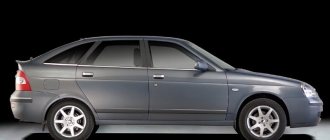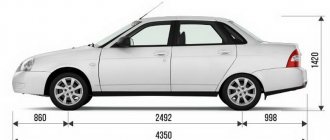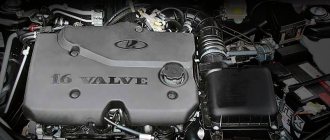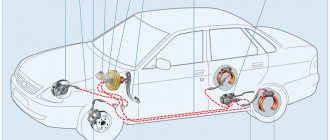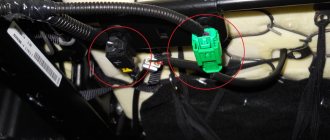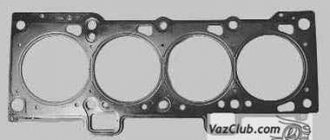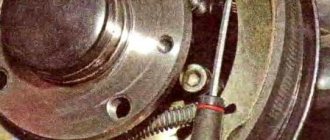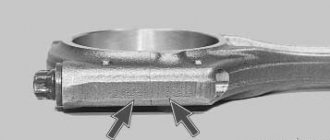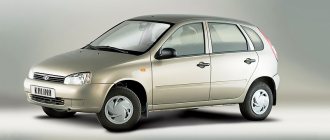In 2014, Lada Priora lost the simplest “Standard” configuration. Now, instead of it, the most accessible one is “Norma”. It was this version that became the most popular among buyers. This is mainly due to the low price and practicality of the car. Let's look at what comes in this package and what are the main differences from the "Lux".
Dimensions
The Lada Priora with a hatchback body has the most “modest” dimensions in its series. The length of the five-door version is only 4.24 meters, the three-door version is slightly shorter - 4.21. The height parameters are average, in comparison with the low-set sedan and the high “station wagon” - 1.43 meters.
The width is the same as other body types - 1.68 meters. Almost all versions have a clearance height of 16.8 centimeters, with the exception of the “Sport” line, where it is slightly lower.
Equipment
For the Lada Priora sedan, hatchback and station wagon in the “Norma” configuration, all three engine types are available:
- VAZ 21126, 1.6 l 16 cl., manual transmission 2180, 72 kW/98 hp.
- VAZ 21127, 1.6 l 16 cl., manual transmission 2180, 78 kW/106 hp.
- VAZ 21127, 1.6 l 16 cl., AMT 2182, 78 kW/106 hp.
All configurations include the following options:
- Safety : driver airbag; larger vacuum brake booster – 9″; ventilated disc brakes on the front wheels; reinforced body frame; energy-absorbing inserts in the front doors; front and rear bumper reinforcement; safe (without the formation of sharp edges upon impact) material for interior parts; energy-absorbing insert in the steering shaft housing; popliteal bar in the instrument panel; electric headlight level control; inertial seat belts (2 front/2 rear, middle rear – static); indication of driver's seat belt not fastened; height adjustment of front seat belts; rear seat headrests are L-shaped; immobilizer; anti-theft alarm with remote control; daytime running lights (DRLs).
- Interior : fabric seat upholstery; door trims with fabric inserts; tufted floor/trunk carpets; seat padding made of polyurethane foam; an armrest with a container for small items between the front seats; rear seat with center armrest and access to luggage compartment; lamps for lighting the luggage compartment and glove box; adjusting the brightness level of the backlight of controls, ignition switch, instruments; “electric package” system with multiplex control from a module in the driver’s door; Driver's tools: jack, combination wheel wrench; full-size stamped-welded spare wheel.
- Comfort : electric drive and heated exterior mirrors; container for glasses; air filter entering the cabin; heat-absorbing glass; tilt-adjustable steering column; alarm for an open hood and trunk lid; electric trunk lid lock with remote control and control from the passenger compartment; central locking with remote control; remote control of raising (lowering) windows when locking (unlocking) doors, respectively; single key for ignition and door locks.
- Exterior : exterior handles in body color; electric windows for front doors; bumpers in body color; floor sill fairings; front wing guards (lockers); rear/front wheel aprons; chrome hood/trunk lid moldings; body paint pastel or metallized.
Engine after restyling
Coming off the assembly line in 2007, the car was equipped with 1 of 3 engines that were released gradually. Technical characteristics of LADA Priora 2010 look like this:
- Engine with 8 valves and 81 hp. At peak it produces 171 kilometers per hour, which was not bad at the time of release. Many drivers complained about inefficient fuel consumption: 7.5/100. Versions with this engine cost less than others, but they also ate much more gasoline.
- The 16-valve engine had 89 horsepower and could reach up to 176 kilometers. Fuel consumption is lower - 7.2 liters. In general, this medium engine was installed on the Optima version.
- The most “Top” version was equipped with an engine with 16 valves and 98 horsepower. It could accelerate 183 kilometers and consumed 7.4 liters.
Please note that now it makes no sense to buy cars produced before restyling. Buying spare parts can cost a pretty penny.
Lada Priora
Lada Priora appeared in 2007 as a replacement for the obsolete 110 model family. The new car was essentially a deep restyling of the tenth series, therefore the platform, some body panels, as well as many components and assemblies, were borrowed from its predecessor. Compared to the previous model, the car received a number of improvements. The ergonomics of the cabin have improved, and the architecture of the center console has changed. In particular, Priora began to be equipped with an anti-lock braking system, and air conditioning appeared in the list of options.
Currently, Lada Priora is available in sedan, hatchback, station wagon and coupe (three-door hatchback) body styles. There are two 1.6-liter power units with a capacity of 87 and 98 hp to choose from. with a non-alternative 5-speed manual transmission.
Despite the fact that Priora continues to be one of the best-selling cars in Russia, AvtoVAZ intends to discontinue it in 2015. The reason for the early “death” is the release of a new competing model, the father of which was the famous designer Steve Mattin, who came to the Russian company in 2012.
The main factor that explains the success of the car in the central regions is its reasonable and affordable price. If you dig deeper, the Lada Priora is an improved model of the Lada 2110. Unlike the “ten,” the new model has several thousand design changes and a number of new parts. A team of AvtoVAZ specialists worked on the design. The team was helped by colleagues from the Italian studio Carcerano. As a result, the salon turned out to be comfortable and cozy. The developers offer the Lada Priora model in three configuration options: “standard”, “norm”, “luxury”. Today the car is available for purchase at all official dealerships.
Lada Priora is a representative of the family of budget small class cars. At the beginning of March 2007, a thousand sedans rolled off the plant's assembly line. Sales started in mid-April. In February of the following year, the production of hatchback models began, and in October, the official presentation of the Lada with a station wagon took place at the Krasnodar car showroom.
The developers released a limited version of the “coupe” modification based on the Priora; a convertible was being designed.
In 2009, Priora displaces the “ten” from production. In 2012, the number of models produced exceeded 650 thousand cars.
In the eleventh year, they decided to slightly modify the car: they replaced the front bumper, steering wheel and rear-view mirrors. New functionality has been added. For the “standard” assembly, an eight-valve engine is installed, which has a lightweight connecting rod and piston group.
At the end of September 2013, significant changes affected the interior and exterior of the car. Due to the changes, the level of comfort and safety has increased. The appearance has acquired a certain gloss. The running components of the car have been modernized. The head optics now have daytime running lights, noise insulation has been improved, and a directional stability system has been added.
The production of the Lada Priora AMT version started in September. The main difference between this version and the previous ones was the automated gearbox. This is a direct development of AvtoVAZ designers, which was created using a five-speed gearbox using an electric actuator and an electronic control unit as a basis.
Since the middle of last year, the family of cars has been equipped with a VAZ-2181 5-speed manual transmission, with cable shift drive.
Characteristics
VAZ 2172 or Priora in a hatchback body is a car of the Priora family. This body type is quite popular and is not inferior in its characteristics to a sedan. Its main differences are the body type and interior design. This Lada Priora model has a large trunk. Folding down the rear seats increases the size of the trunk. The Lada Priora hatchback is equipped with a 16-valve engine with a volume of 1.6 liters and a power of 98 horsepower. These figures are quite impressive for a car that weighs slightly more than 1.5 tons.
As soon as the VAZ 2170, a Priora sedan, went on sale, buyers immediately faced the question: is this a new model or a slightly modified old version? Answering this question can leave you scratching your head, so let’s look at the technical characteristics of the model. The sedan is a car that is now supporting the mighty arsenal of AvtoVAZ on its shoulders. The car occupies a leading position in sales in Russia. So far, not a single budget foreign model has managed to come even slightly close to the official sales figures for the Lada Priora sedan in Russia.
The main advantages of the car: stylish and modern design, engines with a volume of 16 liters, 8 and 16 valves, and, importantly, an affordable price. If it were not for the build quality, which leaves much to be desired, the Lada Priora sedan could lay claim to leadership in its class. But still, the sedan is a confident step forward in the development of the automotive industry.
The Priora sedan has an optimal balance between quality and price. Lada Priora is, first of all, comfort, reliability, ease of operation and safety. In the Samara region, the car tops the ranking of top cars. This trend will continue until a car of better quality, but with the same set of characteristics, appears on the domestic market. The main disadvantage of the sedan is the low build quality.
Elegance
The style of Lada Priora is a combination of lightness, simplicity and conciseness. A car always speaks of the status of its owner. Priora is chosen by people who stand firmly on their own two feet and clearly understand what they need in life. The style is distinguished by its conservatism. Modern fashion trends can be seen here in graceful and elegant lines. The recognizable design is formed by bright lighting technology, the original structure of the radiator grille and its chrome edging. The rear bumper, unlike other models, is distinguished by its style and functionality. The lower part of the bumper, which is exposed to dirt, is painted black. The upper part of the bumper, as before, is painted in body color. Due to this design solution, the car looks like a solid and finished product. Soft-look material is used for upholstery of doors and instrument panels. The solidity of the interior is emphasized by noticeable splashes of chrome.
Exterior
When the exterior was being developed, most of the designers’ mistakes that they made when developing the “tens” were eliminated. The clear boundary separating the roof and the body in the area of the C-pillar, inappropriate and absurd for a wedge-shaped sedan, has vanished into oblivion. Now this transition has become smooth. The ridiculous arch on the rear wheels, which has been subjected to merciless criticism more than once, has disappeared into oblivion. An improved arch replaced it. The developers removed the meaningless and unnecessary solid strip of rear lights, which stretched from side to side. Now the line has been replaced by two lights located along the trunk lid, which visually makes the car wider. Less pronounced shortcomings were also improved. This approach made it possible to disown the awkward appearance of its predecessor. The appearance was given a significant youthfulness by improved lighting technology and a spoiler built into the trunk lid. Specialists managed to reduce the gap space between body parts several times, this was achieved thanks to improved assembly technology. And the combination of such parts as the wing, headlight and bumper is now like a picture. In general, the designers managed to disown the nickname “pregnant antelope” and create a new generation car. The manufacturer provides a six-year warranty for each body type. Thanks to the use of galvanization, it was possible to enhance the anti-corrosion protection.
Interior
AvtoVAZ designers and Italian colleagues worked painstakingly to develop the interior. They created an interior that combines style, elegance and comfort. The interior of the Lada Priora consists of an instrument panel equipped with a trip computer, a silver console panel, next to which a clock of an unusual design is conveniently located, an armrest with built-in niches for items. The interior upholstery has become of higher quality and better. The driver's seat for the “standard” configuration was equipped with an airbag. In the “Lux” assembly, the airbag protected not only the driver, but also the passenger in front. A multiplex system was added to control the electric drives in the doors. Improved seals for the rear and windshields, a reduced level of noise absorption, and energy-absorbing inserts on the front doors made it possible to reach modern requirements in interior design. The interior space remains unchanged. The shortcomings that could not be eliminated include: the short length of the skids in the front seats, which is why a tall driver, whose height reaches 180 cm, will feel uncomfortable in the cabin. The steering column is adjustable only in height.
Safety
In order for the Lada Priora to obey on the road and protect the driver and passengers, a modern security system was installed on the car.
A car equipped with headlights with daytime running lights is visible on the road at any time. The on/off mode is automatic and is activated when the driver turns the key in the ignition. The brake light and LED tail lights operate much faster, while the brightness of the light is increased. The strength of the frame in the body is reinforced by safety bars.
In the event of a rear-end collision, foam inserts located between the body and bumper can absorb energy more effectively. Side airbags are provided for both the driver and passenger seats. The installed exchange rate stability system makes the high-speed car truly safe. The body frame was modified taking into account the standards of the EuroNCap program. The anti-lock braking system was supplemented with a specialized assistant. When emergency braking occurs, the pressure level in the system will increase until the ABS is activated. The improved ISOFIX system, which is responsible for the reliability and speed of fixing child seats, is installed on Lada Priora.
Comfort
Lada Priora is suitable for both urban and highway use. Even when the roads are poorly paved, you feel comfortable and convenient. In cold weather the interior quickly warms up and in hot weather it cools down quickly.
Thanks to the relief of the seats, every trip has now become a real pleasant pastime. The updated seat adjustment mechanism has become much more convenient for drivers whose height is above average. To improve acoustic comfort, over a dozen elements of the car were modernized. The upholstery was changed, the door mechanism was improved, the center armrest, engine mounts and headrests were improved.
The instrument cluster is now easier to read. It was possible to radically improve the clarity of shifts thanks to the modernization of the cable-driven gearbox. Due to this, it was possible to reduce the forces of lever vibrations. The exchange rate stability system provides uninterrupted control over the optimal and comfortable mode of movement both within the city and beyond.
The car can move in an “automated” mode thanks to a transmission that accommodates any driving style.
The automated manual transmission of Lada Priora means reduced fuel consumption, comfort, and two comfortable pedals. You get the feeling that next to you is a driver who is careful, attentive and experienced.
The improved level of aerodynamics of the rear bumper allows you to keep the parking sensors clean for a long time. The functions of the on-board computer are performed by a multimedia system with touch controls and a liquid crystal screen.
The design of the steering column switches has been completely redesigned. Added the ability to program the cruise control and speed limiter systems. Heating adjustment in three directions is available using heating switches on the front seats. A “polite light” function has been added to the lighting unit. The climate system is controlled by pressing the handle. The automatic activation of the windshield wipers is controlled by a rain sensor. This function is indispensable in rainy weather and helps when your car is splashed with water by passing cars.
The reflective surface of the exterior mirrors has been increased and LED turn signal repeaters have been added. The trunk and door locks are remote controlled. The seat lights turn on when entering or exiting. Reducing gasoline consumption and increasing engine resources is achieved with the option of a pre-heater.
For the luxury package, the car was equipped with an airbag for both driver and passenger, front seat belt pretensioners, a car parking system, and ABS. The body was strengthened to increase the passive level of safety. The torsional rigidity of the body has increased, and this change especially affected the second phase of the body. The release of the “Lux” assembly began in May 2008.
As a result of the crash test conducted by Autoreview, according to the ARCAP method, the Lada Priora, which was produced before 2008, received about six points out of a possible 16 for a frontal impact and nine points for a side impact. Such figures indicate that the car can only qualify for 3 stars. These figures are comparable to some older Korean-made models. In order to increase the level of safety, the body has been modernized in all Lada trim levels. A crash test for this configuration is today carried out by AvtoVAZ specialists with the involvement of the media. According to the data provided by the company, the car was able to score slightly more than ten points out of 16 possible for a frontal impact, and 13 for a side impact. In order for the car’s rating to rise to four, the Lada Priora must receive a total of 24 points. At the time of testing, the car scored 23.56 points. European safety agencies use rounding methods in such cases, which means that the car's passive safety level has reached the desired level of four points.
According to the manufacturers, if an impact occurs at a speed of 5 km/h, the bumper will be damaged, while the rest of the body will remain unaffected.
Engine Features
The Lada Priora and all its modifications are equipped with the VAZ 21126 engine. Its development took place simultaneously with the VAZ 11194 internal combustion engine. Although these engines have different displacements, most of the engine components and systems are similar. The main task that the designers set for themselves was to increase the service life of the main components. The VAZ 21124 was taken as a basis. The use of an innovative approach and the introduction of new technologies made it possible to increase the engine service life.
In the VAZ 21126 engine, the cylinder diameter is 82 mm. The height of the block from the axis of rotation of the crankshaft to the upper surface of the cylinders is 197.1 mm. The main significant difference between this engine is the quality of processing of the cylinder walls and the height of the blocks. To obtain a high-quality working surface, the cylinders are honed according to the Federal Mogul method.
The block was given a new index - 21126-1002011. In order not to confuse the blocks, it was painted gray and marked. Markings were applied to the bottom plane of the block. For the engine, the crankshaft model is used - 11183-1005016. The landing dimensions of the shaft correspond to the VAZ 2112. However, on the 11183 shaft the crank radius was increased, now it is 37.8 mm, and the piston stroke is 75.6 mm. The crankshaft toothed pulley is considered original and its index is 21126. The pulley tooth profiles were calculated for a timing belt with semicircular teeth. To avoid the belt slipping, on the one hand, a belt was installed on the pulley, and on the other, it was equipped with a special washer. A damper with index 2112 is installed on the shaft for attached units and the generator drive. The damper is combined with a toothed disk. Thanks to the toothed disk, the position of the crankshaft is monitored.
The connecting rod is made thin. The sides do not contact the crankshaft. This technology allows to minimize losses during friction. During the installation of pistons, it is necessary to ensure that the accuracy class of the piston corresponds to the class of block cylinders. The piston is marked on the bottom.
The connecting rod index is 11194, it has a lightweight, elongated design. It is manufactured using new techniques. Dina is 133.32 mm. The lid is made by breaking part of the workpiece. By combining the surfaces obtained in this way, high accuracy is achieved for the holes for the shaft journal. Bolts are used to secure the connecting rod. After the connecting rod has been disassembled, the bolts must be discarded. Their reuse is unacceptable. For the connecting rod, liners are used, the width of which is 17.2 mm.
Piston rings with a diameter of 82 mm, which are installed on new pistons, are thinner in contrast to traditional factory ones. The height of the upper ring is 1.2 mm, the lower one is 1.5 mm, the oil scraper ring is 2 mm.
The outer diameter of the piston pin is 188 mm, length 53 mm. The cylinder head has 16 valves, its main difference is the expanded front surface area. An increase in the platform is necessary for a convenient location of the timing mechanism. The platform of the pipeline flanges was increased. Glasses of candle wells are cast together with the heads.
From the model 2112 engine, valves, springs, camshafts and hydraulic lifters were inherited.
Through the use of hydraulic pushers, it was possible to compensate for the valve drive clearances. This approach allows you to do without adjusting the gaps in the valve mechanism during operation.
Engine after restyling
The technical characteristics of the Lada Priora hatchback have changed somewhat after restyling in 2013. In the new version only 2 engines were released:
- In the younger model, the engine has become more economical (consumption of only 6.9 liters), with increased power - 98 horsepower. Maximum acceleration is 183 kilometers.
- In the older version, the engine became more powerful - 106 horsepower, but with the same speed characteristics. Consumption dropped to 6.8 liters.
Configurations of Lada Priora VAZ 2170 and other modifications
VAZ 2170 is known in the following configurations:
- “Standard” is the most budget package. It lacks: audio radio, speakers, air conditioning, rear headrests, immobilizer, central locking, heated front seats, electric drive and heated exterior mirrors, fog lights, remote trunk release. The front windows are electric, the rear windows are mechanical. The engine is 81 hp, which has been discontinued since 2013, and at the moment there are no longer orders for this configuration;
- “Norma”, which is equipped with an 87-, and after restyling - only a 98- and 106-power engine. Available: audio preparation, on-board computer, electric heating and electric drive of exterior mirrors, immobilizer, anti-theft alarm and all the elements of the “standard” equipment plus some new equipment. This configuration is in greatest demand due to its price niche. When you need a car “yesterday”, you have to buy what you have enough money for now, and everyone else has to retrofit the car in the process.
- "Norma+". In fact, this is the same standard for which one or more items of equipment are set: air conditioning, audio radio with speakers, ABS + BAS, child seat mounts, heated front seats and windshield;
- “Lux” is the most rich in functionality. It has everything that the “norm+” has, and in addition: side airbags, an airbag for the front passenger, rear and front electric windows, a navigator, a multimedia system, cruise control, parking sensors, fog lights, a rain sensor, a climate system , alloy wheels, heated front seats;
- “Sport” is a special package that increases the “sports” component. This is an aerodynamic body kit: a pronounced bumper with a spoiler, side sills, a diffuser rear bumper, and a wing on the trunk lid. The wheels with narrow profile tires are also different. Ground clearance, curb weight (up to 1080 kg) and maximum weight (up to 1500 kg) have been reduced. The interior has also been transformed: side supports have been added along the edges of the seats with red stitched seams, carbon fiber inserts, and a leather steering wheel. Air conditioning, radio, and a full set of electric windows are included. However, the production of sports Prioras was limited and today they are discontinued, although they can be found here and there on the highway, and most often these are Priora coupes.
Of course, this is not a complete, but only an indicative overview of the configurations of the Lada Priora, which is hardly possible to present in its entirety within the confines of one article. In addition, the equipment also differs somewhat depending on the body type. For example:
- Prior station wagons have roof rails, brackets on the wheel arches of the trunk, for which cargo can be strapped;
- For the coupe body, folding backrests and a reinforced frame of the front seats have been developed.
Body
In all versions of the Priora, the bodywork is mediocre. Drivers and experts had 2 complaints:
Susceptibility to rust. The body is made of ordinary steel, without alloying additives. For this reason, after the first winter it begins to actively rust and it will not be possible to stop this process.
Poor paintwork. Some noticed that it began to fall off in large “chips.” You will have to constantly visit the paint shop to paint over them, otherwise the corrosion process will be unstoppable.
Transmission
Initially, the hatchback came with a manual transmission. In fact, it was a strengthened version of the gearbox from the 110th Lada. Drivers immediately noted the poor quality of the mechanics, which became known for having very poor synchronizers. Often the handle simply “jumped” out of gear or the desired mode simply did not turn on.
The release lever began to knock just 3 months after purchase, and unclear shifts were observed immediately from the passenger compartment.
Subsequently, the restyled version of “2180” received updated mechanics, which worked much smoother. The sudden knocks disappeared and shifts became smooth. Afterwards, AvtoVAZ updated the gearbox and installed a robotic version, which received mixed reviews. However, it is very reliable and convenient; there are no reviews about its inoperability.
Summary data for Lada Priora (before restyling 2013)
The VAZ 2170 (this is exactly the indexing that Priora received) has an improved interior compared to the “ten”, a 16-valve engine with a volume of 1596 cc. see, and a 5-speed manual transmission in all trim levels (in the first trim levels of the sedan and hatchback with an 80 hp engine, an 8-valve engine was installed). In mixed driving mode, the Priora has 100 km. it takes from 6.6 to 7.6 liters. fuel outside the city (depending on the configuration), and in the city - 9.8 liters. The new engine allows you to accelerate to 180 km/h, and to “hundreds” in 12 seconds. This property attracts the attention of fans of high-speed racing, because by working on the engine and tuning the car, you can achieve good sports performance.
Technical modification data
The modification is a good budget car. It belongs to class B and has a high degree of environmental friendliness - Euro4.
How much does a Hatchback body weigh? In factory configuration, without load, its weight is only 1088 kilograms.
Compared to other versions of the Priora, the suspension was not strengthened here. The front spring remained independent, and the rear was partially independent. The front brake is ventilated and has a disc locking type, the rear brakes are drum brakes. The use of a robotic automatic transmission in the modification made the car “friendlier” and easier to drive, even for inexperienced drivers.
The headlight glass has been changed in many ways to better distribute light. The body, interior, steering wheel and multimedia devices were also slightly changed.
